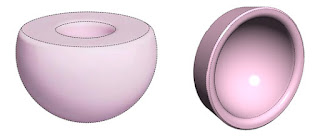TTAB Grants Petitions for Cancellation of Registrations for the Color Pink for Hip Joint Implants on the Ground of Functionality
In an exhaustive 107-page opinion, the Board granted petitions for cancellation of two registrations on the Supplemental Register for the color pink applied to the entire surface of hip joint implants, on the ground of Section 2(e)(5) functionality. This blog post will make no similarly exhaustive attempt to summarize the decision, but instead will repeat the conclusions along with some of the reasoning. C5 Medical Werks, LLC v. CeramTec GmbH, Cancellations Nos. 92058781 and 92058796 (December 6, 2022) [not precedential] (Opinion by Judge Jonathan Hudis).
The challenged registrations cover only the color pink, not the product configurations shown in the drawings above. Respondent’s expired patent, as well others of its patents, disclose the utilitarian advantages of adding Cr3+ ions to ZTA ceramic hip replacement component materials with respect to the toughness, hardness, stability and suppression of brittleness of the ZTA ceramic. As a natural byproduct, this addition of chromium oxide (chromia) in its ionic form turns the chemical compound pink
The advertising and public statements made by Respondent and its OEM customers on its behalf touted the utilitarian advantages of adding chromium oxide to Respondent’s ZTA ceramic compounds; some statements were made in conjunction with the comment that the addition turns the material pink.
As to the availability of alternative "designs" (i.e., colors), there was a dearth of relevant evidence, and so that factor was neutral. In view of the parties’ testimony that the use of chromium oxide either does not affect the cost of a ZTA ceramic or makes the product more expensive, "whether the addition of chromia (turning the product pink) results from a comparatively simple or inexpensive method of manufacture is also a neutral factor."
The Board concluded that the registered marks are de jure functional:
In sum, we find that the color pink (caused by the addition of chromia) of the compound used to make ceramic hip implant components, as shown in Respondent’s trademark registrations, is functional based on utilitarian considerations.
Read comments and post your comment here.
TTABlogger comment: Lots of technical discussion and expert testimony.
Text Copyright John L. Welch 2022.





3 Comments:
"Respondent’s expired patent, as well others of its patents, disclose the utilitarian advantages of adding Cr3+ ions to ZTA ceramic hip replacement component materials with respect to the toughness, hardness, stability and suppression of brittleness of the ZTA ceramic. As a natural byproduct, this addition of chromium oxide (chromia) in its ionic form turns the chemical compound pink."
Sounds like it could have been a straightforward 10-page opinion.
It seems as though the TTAB conflates the functionality of chromia with the functionality of the color pink. Just because the color pink is a natural byproduct of adding chromia doesn't mean that the finished product must be pink to function as intended. As established in the analysis of the Morton-Norwich factors (1) there are other designs available to competitors (i.e., other colors can be and are in fact used, therefore competitors need not use the color pink on their finished products) and (2) the design is relatively simple and inexpensive to manufacture (as evidenced by Petitioner's comments regarding cost to manufacture both pink and white products), so there should be a minimal burden (if any) for competitors who use chromia in these devices to change the color to one that isn't already registered trade dress.
If the color pink is a natural by-product of using a certain amount of Chromia, then giving them ownership of the color pink is effectively given them a perpetual patent monopoly, directly conflicting with the limited term granted under patent law.
Post a Comment
<< Home